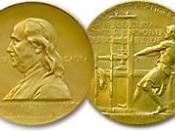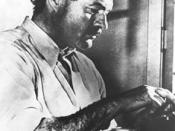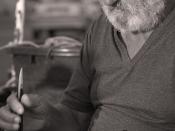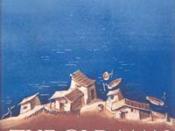The Old Man and The Sea A short novel by a great author named Ernest Hemmingway, The Old Man And The Sea, is the book I read. It was published in 1952. This book is "nearly faultless" as Malcolm Cowley of the New York Herald Tribune said. Other critics described it as a masterpiece, one of his best writings. In 1953, this short novel won the Pulitzer Prize. The year after that it won the Nobel Prize.
The Old Man And The Sea is set in the mid-twentieth century in Cuba and the Gulf Stream. The gulf stream being where the old man was beaten and Cuba his home. The characters in this novel are Santiago, the old Cuban fisherman; Manolin, a young boy and Santiago's closest friend; Martin the owner of the terrace which gives food for the old man; Pedrico, he receives the head of the marlin to use in fish traps; Rogelio, a young boy who once helped Santiago with his fish nets; the marlin, an eighteen foot catch and the largest fish ever caught in the Gulf; Los Golanos, scavenger sharks whom destroy the marlin; and the Mako, a sleek killer of the sea which is known for the eight rows of raking teeth.
In this novel, Hemmingway, with his descriptive details, make the characters sound so realistic; he makes them come "alive." For eighty-four days, Santiago had not caught a single fish. At first Manolin had shared his bad luck, but after the fortieth day the boy's father tells his son to go on another boat. From that time on, Santiago works alone. Each morning he rows his skiff into the Gulf Stream where the big fish are. Each evening he comes back empty-handed.
On the eighty-fifth day Santiago rows out of the harbor before dawn. After leaving the smell of land behind him, he set his line. The line went straight down into the deep water. Later, with the aid of a hovering man-of-war bird, he sees a school of flying fish but is going too fast and too far away. The bird circles again and again and the old man sees a tuna which he hauls onto the skiff. Toward noon, a marlin starts nibbling on the line. The old man knew it is a big fish so he did not let go even when the fish is dragging him further out to sea. The fish injures Santiago: cut his cheek and hand and cramps his hand, but he did not let go. Finally, the fish starts to circle the skiff and when it circles close to the skiff the old man harpoons it and then lashes the marlin to the bow and stern.
An hour later he sights the first shark. It is a fierce Mako, and it comes in fast to slash with raking teeth at the dead marlin. With failing might, the old man strikes the shark with his harpoon. The Mako rolls and sinks, carrying the harpoon with it and leaving the marlin mutilated and bloody. Santiago knew the scent would spread. Serveying, he sees two shovel-nosed sharks closing in. He strikes at one with his knife lashed to the end of an oar and watches the scavenger sliding down into the deep water. The other he kills while he tears at the flesh of the marlin. When the third appears, he stabs at it with the knife, only to feel the blade to snap as the fish rolls. The other shark came at sunset. At first he tries to club them with the tiller from the skiff, but his hands are cut up and bleeding and there are too many in the pack. In the darkness, as he steers toward the faint glow of Havana, he hears them hitting the carcass again and again. His great tiredness and steering are all he thinks about. He knows they would leave him nothing but the bare skeleton of his great catch.
All lights are out when he sails into the harbor. In the gloom, he could just make out the white backbone and the upstanding tail of the fish. He starts up the shore with the mast and sail of his boat. Once, he falls under their weight and lies patiently until he could gather his strength. In his shack, he falls on his bed to sleep.
There the boy finds him later that morning. Meanwhile other fishermen gather about the skiff and marvel at the giant marlin. When Manolin returns to Santiago's shack with hot coffee, the old man wakes up. Manolin tells him to rest, so he can make himself fit for the days of fishing they will have together. All that afternoon the old man sleeps satisfied that he earns respect of the town. Santiago is dreaming of lions.
The Old Man And The Sea is a magnificent book for all kinds of readers. Like most great stories, it can be read on more than one level of meaning. On one, it is an exciting but tragic adventure story. Maintained by the pride of his calling, the only pride he has left, a broken old fisherman ventures far out the Gulf Stream and there he hooks the biggest fish ever seen in those waters. Then, alone and exhausted by his struggle to harpoon the giant marlin, he is forced into a loosing battle with the sharks; they leave him nothing but the skeleton of his catch. On another level, the book is a fable of the unconquerable spirit of man, a creature capable of snatching spiritual victory from circumstances of disaster and material defeat.
The struggle between the marlin is a beautiful depiction of courage and resilience, but I begin to wonder who is hooked into whom. The old man and the fish are one and their lives become connected through that line as they live each moment according to the other's actions. Even the old man is not sure who is better, him or the marlin, and he mentions several times they are not that different. Whether or not the sharks ate his fish, it only matters that the old man brought him to the boat and defeated him.





